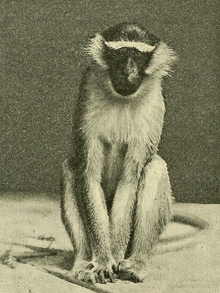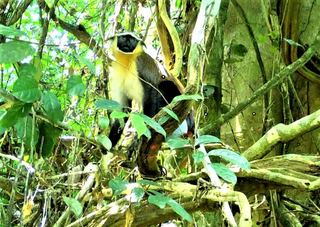
The Dryas monkey, also known as Salonga monkey, ekele, or inoko, is a little-known species of Old World monkey found only in the Congo Basin, restricted to the left bank of the Congo River. It is now established that the animals that had been classified as Cercopithecus salongo were in fact Dryas monkeys. Some older sources treat the Dryas monkey as a subspecies of the Diana monkey and classify it as C. diana dryas, but it is geographically isolated from any known Diana monkey population.

The vervet monkey, or simply vervet, is an Old World monkey of the family Cercopithecidae native to Africa. The term "vervet" is also used to refer to all the members of the genus Chlorocebus. The five distinct subspecies can be found mostly throughout Southern Africa, as well as some of the eastern countries. These mostly herbivorous monkeys have black faces and grey body hair color, ranging in body length from about 40 cm (16 in) for females, to about 50 cm (20 in) for males.
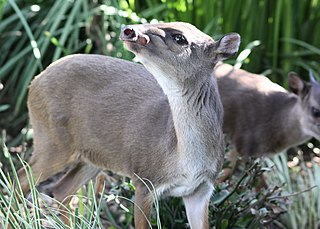
The blue duiker is a small antelope found in central, southern and eastern Africa. It is the smallest species of duiker. The species was first described by Swedish naturalist Carl Peter Thunberg in 1789. 12 subspecies are identified. The blue duiker reaches 32–41 centimetres (13–16 in) at the shoulder and weighs 3.5–9 kilograms (7.7–19.8 lb). Sexually dimorphic, the females are slightly larger than the males. The dark tail measures slightly above 10 centimetres (3.9 in). It has short, spiky horns, around 5 centimetres (2.0 in) long and hidden in hair tufts. The subspecies show a great degree of variation in their colouration. The blue duiker bears a significant resemblance to Maxwell's duiker.

The grivet is an Old World monkey with long white tufts of hair along the sides of its face. Some authorities consider this and all of the members of the genus Chlorocebus to be a single species, Cercopithecus aethiops. As here defined, the grivet is restricted to Ethiopia, Sudan, Djibouti, and Eritrea. In the southern part of its range, it comes into contact with the closely related vervet monkey and Bale Mountains vervet. Hybridization between them is possible, and may present a threat to the vulnerable Bale Mountains vervet. Unlike that species, the grivet is common and rated as least concern by the IUCN.

The mantled guereza, also known simply as the guereza, the eastern black-and-white colobus, or the Abyssinian black-and-white colobus, is a black-and-white colobus, a type of Old World monkey. It is native to much of west central and east Africa, including Cameroon, Equatorial Guinea, Nigeria, Ethiopia, Kenya, Tanzania, Uganda and Chad. The species consists of several subspecies that differ in appearance. It has a distinctive appearance, which is alluded to in its name; the long white fringes of hair that run along each side of its black trunk are known as a mantle. Its face is framed with white hair and it has a large white tail tuft.

The African brush-tailed porcupine is a species of rat-like Old World porcupine, indigenous to a broad belt of Africa ranging from Guinea on the west coast to Kenya on the east. This is a common species with a very wide range, and despite it being used extensively for bushmeat, the International Union for Conservation of Nature has rated its conservation status as being of "least concern".

The mona monkey is an Old World monkey that lives in western Africa between Ghana and Cameroon. The mona monkey can also be found on the island of Grenada as it was transported to the island aboard slave ships headed to the New World during the 18th century. This guenon lives in groups of up to thirty-five in forests. It mainly feeds on fruit, but sometimes eats insects and leaves. The mona monkey has brown agouti fur with a white rump. Its tail and legs are black and the face is blue-grey with a dark stripe across the face. The mona monkey carries food in cheek pouches.

The western red colobus, also known as the bay red colobus, rust red colobus or Upper Guinea red colobus, is a species of Old World monkey in West African forests from Senegal to Ghana. All other species of red colobuses have formerly been considered subspecies of P. badius. It is often hunted by the common chimpanzee. In 1994, western red colobus monkeys infected many chimpanzees with Ebola virus when the chimpanzees hunted the monkeys as prey.

The malbrouck is an Old World primate from Africa that belongs to the genus Chlorocebus. The species is sometimes classified as a subspecies of the vervet monkey, or of the widespread grivet.
The montane hylomyscus or montane wood mouse is a species of rodent in the family Muridae. A long-coated species with brownish-grey upper parts and whitish-grey underparts, it occurs in the uplands of tropical Central Africa where its natural habitat is tropical moist montane forests.

Hildegarde's broad-headed mouse or Hildegarde's zelotomys, is a species of rodent in the family Muridae. It is found in Central Africa.

The lesser spot-nosed monkey, also known as the lesser spot-nosed guenon, lesser white-nosed guenon, or lesser white-nosed monkey, is a species of primate in the family Cercopithecidae. It is found in Ivory Coast, Ghana, Guinea, Liberia, Sierra Leone, Togo, Guinea-Bissau, and possibly Senegal.

The crested mona monkey, also known as the crowned guenon, crowned monkey, golden-bellied guenon, or golden-bellied monkey,, is a species of African primate in the family Cercopithecidae found in west central Africa.
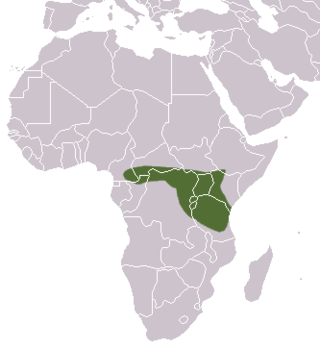
Hildegarde's shrew is a species of mammal in the family Soricidae. It is found in Burundi, Cameroon, Central African Republic, Republic of the Congo, Democratic Republic of the Congo, Ethiopia, Kenya, Rwanda, and Tanzania. Considered by some authorities to be a subspecies of Crocidura gracilipes, it is now recognised as a separate species, with a diploid chromosome number of 2n = 52. This is one of three species of small mammal named by the British zoologist Oldfield Thomas in honour of anthropologist Hildegarde Beatrice Hinde.

The Ethiopian epauletted fruit bat is a species of megabat in the family Pteropodidae. It is found in Burundi, Chad, Republic of the Congo, Democratic Republic of the Congo, Eritrea, Ethiopia, Kenya, Malawi, Mozambique, Nigeria, Rwanda, Sudan, Tanzania, and Uganda. Its natural habitat is savanna.
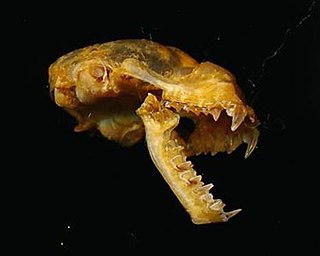
The Benito roundleaf bat is a species of bat in the family Hipposideridae found in Cameroon, Central African Republic, Republic of the Congo, Democratic Republic of the Congo, Ivory Coast, Equatorial Guinea, Gabon, Ghana, Guinea, Liberia, Nigeria, Sierra Leone, South Sudan, and Togo. Its natural habitat is subtropical or tropical moist lowland forests.

The Mongalla free-tailed bat is a species of bat in the family Molossidae. It is found in Burkina Faso, Cameroon, Democratic Republic of the Congo, Ivory Coast, Ghana, Kenya, Mali, Sudan, and Uganda. Its natural habitats are dry savanna, moist savanna, and subtropical or tropical seasonally wet or flooded lowland grassland.

The Sanje mangabey is a highly endangered Old World monkey of the white-eyelid mangabey group from the Eastern Arc Mountains in Tanzania. They are about 50–65 centimetres (20–26 in) in length, excluding the tail, and their body colour is greyish. Fruit makes up about 70% of their diet. They live in valley forests and on mountain slopes, but are mostly ground-dwelling, which makes them susceptible to hunting and poaching. Their habitat is being degraded, and the International Union for Conservation of Nature has assessed their conservation status as being "endangered".

The Osman Hill's mangabey, also known as the rusty-mantled mangabey, is a subspecies of the grey-cheeked mangabey, a crested mangabey in the family Cercopithecidae, with a restricted distribution in West Africa.

The red-tailed monkey, also known as the black-cheeked white-nosed monkey, red-tailed guenon, redtail monkey, or Schmidt's guenon, is a species of primate in the family Cercopithecidae.
